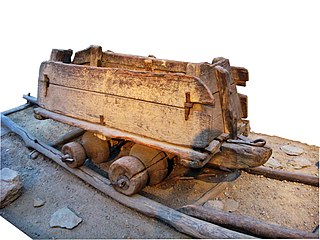
Rail transport is a means of transport that transfers passengers and goods on wheeled vehicles running on rails, which are located on tracks. In contrast to road transport, where the vehicles run on a prepared flat surface, rail vehicles are directionally guided by the tracks on which they run. Tracks usually consist of steel rails, installed on sleepers (ties) set in ballast, on which the rolling stock, usually fitted with metal wheels, moves. Other variations are also possible, such as "slab track", in which the rails are fastened to a concrete foundation resting on a prepared subsurface.

In rail transport, a train is a series of connected vehicles that run along a railway track and transport people or freight. The word train comes from the Old French trahiner, derived from the Latin trahere meaning "to pull, to draw". Trains are typically pulled or pushed by locomotives, though some are self-propelled, such as multiple units. Passengers and cargo are carried in railroad cars, also known as wagons. Trains are designed to a certain gauge, or distance between rails. Most trains operate on steel tracks with steel wheels, the low friction of which makes them more efficient than other forms of transport.
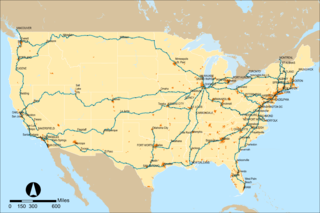
The National Railroad Passenger Corporation, doing business as Amtrak, is a passenger railroad service that provides medium and long-distance inter-city rail service in 46 of the 48 contiguous United States and to nine cities in Canada. Amtrak is a portmanteau of the words America and trak, the latter itself a sensational spelling of track.
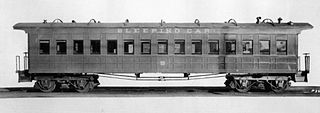
The sleeping car or sleeper is a railway passenger car that can accommodate all passengers in beds of one kind or another, for the purpose of sleeping. George Pullman was the American innovator of the sleeper car.

A conductor or guard is a train crew member responsible for operational and safety duties that do not involve actual operation of the train/locomotive. The conductor title is most common in North American railway operations, but the role is common worldwide under various job titles. In Commonwealth English, a conductor is also known as guard or train manager.

A railcar is a self-propelled railway vehicle designed to transport passengers. The term "railcar" is usually used in reference to a train consisting of a single coach, with a driver's cab at one or both ends. Some railway companies, such as the Great Western, termed such vehicles "railmotors".

A caboose is a crewed North American railroad car coupled at the end of a freight train. Cabooses provide shelter for crew at the end of a train, who were formerly required in switching and shunting, keeping a lookout for load shifting, damage to equipment and cargo, and overheating axles.

In railroad structures, and rail terminology, a wye or triangular junction is a triangular joining arrangement of three rail lines with a railroad switch at each corner connecting to each incoming line. A turning wye is a specific case.
Rail terminology is a form of technical terminology. The difference between the American term railroad and the international term railway is the most significant difference in rail terminology. There are also others, due to the parallel development of rail transport systems in different parts of the world.
Rail transport operations are the day-to-day operations of a railway. A railway has two major components: the infrastructure and the rolling stock
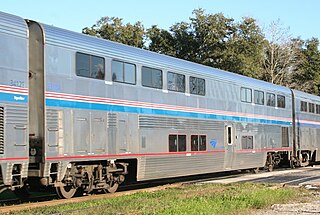
A passenger railroad car or passenger car, also called a passenger carriage, passenger coach, or passenger bogie (India) is a railroad car that is designed to carry passengers. The term passenger car can also be associated with a sleeping car, a baggage car, a dining car, railway post office and prisoner transport cars.

The Maryland Midland Railway is a Class III short-line railroad operating approximately 63 miles of track in central Maryland. It was originally headquartered in the former Western Maryland Railway station in Union Bridge, Maryland: it has since moved to a new facility across from the old station. The railroad has been 87.4% owned by Genesee & Wyoming since 2008, with Lehigh Cement retaining a 12.6% interest.

A brakeman is a rail transport worker whose original job was to assist the braking of a train by applying brakes on individual wagons. The earliest known use of the term to describe this occupation occurred in 1833. The advent of through brakes, brakes on every wagon which could be controlled by the driver, made this role redundant, although the name lives on in the United States where brakemen carry out a variety of functions both on the track and within trains.
This article contains a list of terms, jargon, and slang used to varying degrees by railfans and railroad employees in the United States and Canada. Although not exhaustive, many of the entries in this list appear from time to time in specialist, rail-related publications. Inclusion of a term in this list does not necessarily imply its universal adoption by all railfans and railroad employees, and there may be significant regional variation in usage.

The Catskill Mountain Railroad is a heritage tourist railroad based in Kingston, New York, that began operations in 1982. The railroad leases a 4.7-mile portion of the former New York Central Railroad Catskill Mountain branch from Kingston to Stony Hollow, New York. The tracks are owned by Ulster County, New York, which bought them in 1979 from the bankruptcy estate of the Penn Central Railroad. The railroad's current permit with Ulster County expires on December 31, 2023.
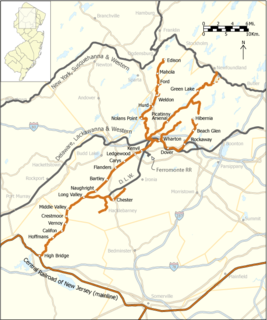
The High Bridge Branch was a branch line of the Central Railroad of New Jersey (CNJ) that started in High Bridge, New Jersey at a connection with the CNJ main line and continued north to iron-ore mines in Morris County. The High Bridge Branch line followed the South Branch of the Raritan River for much of its duration.

A private railroad car, private railway coach, private car, or private varnish is a railroad passenger car either originally built or later converted for service as a business car for private individuals. A private car could be added to the make-up of a train or pulled by a private locomotive, providing privacy for its passengers. They were used by railroad officials and dignitaries as business cars, and wealthy individuals for travel and entertainment, especially in the United States. They were sometimes used by politicians in "whistle stop campaigns". Pay cars with less opulent sleeping and dining facilities were used by a paymaster and assistants to transport and disburse cash wages to railway employees in remote locations without banking facilities.
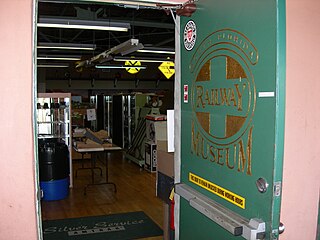
The South Florida Railway Museum is a railroad museum located in the Deerfield Beach Seaboard Air Line Railway Station in Deerfield Beach, Florida. It is operated by volunteers.
The Kew Gardens train crash was a collision between two trains on the Long Island Rail Road's Main Line, which occurred during the evening rush hour of November 22, 1950. The trains collided between Kew Gardens and Jamaica stations in Kew Gardens, Queens, New York City, killing 78 people and injuring 363. The crash is the worst railway accident in LIRR history, and one of the worst in the history of New York State.

The North Alabama Railroad Museum, Inc. is a railroad museum in Chase, Alabama. The museum, incorporated in 1966, is an all volunteer organization. The museum has a collection of rolling stock, a small train station, and a small heritage railroad called the Mercury and Chase Railroad which operates between April and December. The mission of the NARM is to "preserve railroad history in North Alabama and South Central Tennessee." It is run entirely by its 100-plus volunteers. The museum is open to the public daily, volunteers are usually available on Wednesdays and Saturdays. Admission to the museum is free, however there is a charge for riding the trains. A schedule of rides is available at the museum's website.


















